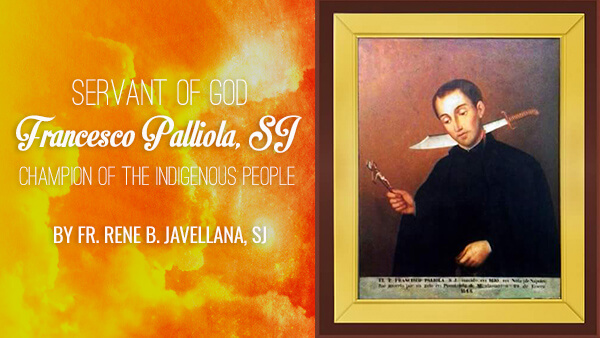


Fr. Rene B. Javellana, SJ
Province Archivist
January 11, 2016
On 9 Jan 2016 at the Cathedral of Our Lady of the Most Holy Rosary, Diocese of Dipolog City, the formal opening of the Canonical Investigation on the Life, Virtues and Martyrdom of Padre Francesco Palliola, SJ was held. Bp. Severo Caermare, D.D. of Dipolog presided. Fr. Patrick Dalangin, Parish Priest of the Municipality of Ponot (Jose Dalman), Zamboanga del Norte was appointed as postulator.
Padre Francesco was killed in Ponot, then a seaside barangay of Katipunan town on 29 Jan 1648. He was born 10 May 1612, entered the Society in 1637, arrived in Manila July 1643, in Dapitan in Dec 1644. He mastered Visayan and preached in it. But seeing how the lumad community of Subanon could barely understand Visayan, he studied and learned the Subanon language. He is credited as being the first European and Jesuit to do so. While stationed at Dapitan, he went on missionary journeys to establish the settlements of Dipolog, Dicayo and Duhinong. When Josef Zanzini (aka José Sanchez) was assigned as his assistant, he left Zanzini in charge of the Visayan communities while he devoted himself to the lumad. He established visitas as far south as the boundaries between present-day Zamboanga del Norte and Zamboanga del Sur. While visiting Ponot to reconcile a Subanon named Tampilo, who had turned away from the Christian faith, he was killed by Tampilo and his co-conspirators in the early morning of29 Jan. While dying, he forgave his enemies, commended himself to Jesus and Mary. He died clutching the rosary and a crucifix he brought from Europe.
Since his death 368 years ago, his memory lingers in Zamboanga del Norte. A street in the Municipality of Manukan is named after him. He figures in the oral stories of the Subanon, remembered as a loving and protective father. The site of his martyrdom has been a place of pilgrimage over the years.
Padre Francesco’s family name has been spelled variously in the primary documents as Palliola, Paliola or Paleola, the Latinized version. The oldest source of his life, the annual letter of 1649 by Francisco Roa uses the Italian version of his name Palliola. The Italian spelling has been chosen for reasons of antiquity and for pastoral reasons. In his hometown of Nola his family is known as Palliola and a principal street in Nola is named P. Francesco Palliola. The investigation into the life and martyrdom of Padre Francesco is supported by the Diocese of Nola and the Church of the Gesù, the former church attached to the Jesuit college of Nola where Padre Francesco studied. The use of the Italian family name builds a bridge between Dipolog and Nola. As signs of Nola’s cooperation and support of this project, the bishop of Nola and the Rector of the Gesù sent letters of congratulations and support to Bp. Caermare. The letters were read at the end of the Mass by Fr. Ofrasio. The letters indicated that Nola was joining Dipolog in celebrating the memory of Padre Francesco. At 9 in the morning on 6 Jan, Nola was scheduled to celebrate a Mass for Padre Francesco.
A copy of a late-18th century oil painting of Padre Francesco, now in the collection of the Metropolitan Museum of Manila, was unveiled at the canonical rites held at the Dipolog Cathedral.
A number of bishops attended the ceremony and the Mass that followed: Abp. Romulo de la Cruz of Zamboanga, Bp. Martin Jumoad of Basilan, Bp. Leopoldo Jaucian of Bangued, and Abp. Jesus Dosado of Ozamis. Fr. Timoteo Ofrasio, SJ was the head MC of both the canonical rites and the Mass that followed. Province Archivist René Javellana, SJ and assistant, Bro. Amado Tumbali, SJ, Frs. Gil Donaire and Atong Ong, SJ of ADZU were also present. Fr. Javellana and Bro. Tumbali represented Fr. Provincial and were designated by the postulator as witnesses to the authenticity of the documents that came from the Jesuit archives in Rome and Manila.
After the opening of the canonical investigation at Dipolog, Padre Francesco Palliola is officially designated as “Servant of God,” a step away from beatification.
The opening ceremony coincided with the anniversary of Padre Francesco’s final vows at Dapitan and the concluding ceremony scheduled on 29 Jan 2017 will coincide with his death anniversary. In 2017, the diocesan phase of the investigation will conclude and the documents and papers gathered by the diocesan investigation will be forwarded to the Congregation of the Causes of the Saints for the Vatican stage of the investigation, which takes charge of beatification and canonization.